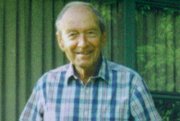Elastics Veteran Siedner Retires After 67 Years in the Apparel Industry
Frank Siedner, a major figure in the American elastics industry and former partner at HJ Nordseth Inc., a Los Angeles-based firm that served as a national selling agency for textile and elastics mills, retired this past spring from the apparel industry after 67 years of service.
Siedner, 86, had enjoyed a brief semi-retirement from the industry after shutting down HJ Nordseth 13 years ago, but then returned to work full time at Komar Apparel in Los Angeles, where he was employed for the past decade. “I’m convinced it is high time for me to retire,” he said. “I’ve had a great career and a wonderful marriage, with a daughter and grandchildren. It’s been great.”
HJ Nordseth represented about 12 mills in its heyday, according to Siedner. And it brought an enormous amount of business to the West Coast from mills throughout the country, particularly in New England and the Carolinas, including Carolace Embroidery Company, Imperial Laces Inc., Artistic Ribbon Company and GH Vanderbeck. Between 1960 and 1980, the company sold between $5 million and $7 million in merchandise each year, Siedner said.
Siedner’s industry experience stretches back to Europe in the years leading up to World War II. He was born to Jewish parents in Berlin. In 1933, with the climate of his homeland starting to change as a result of the Nazis’ ascension to power, he boarded a boat headed to England, where he ended up working as an apprentice for a netting manufacturer called John Heathcoat. He got the job through a business connection his father had. But labor permits were hard to come by, so in 1935 he went to the place he always dreamt of going: The United States.
In New York, Siedner worked for a converter called S&A Stern Company, earning $15 a week with overtime. (He obtained a visa for his parents to join him in New York in 1939).
During World War II, Siedner enlisted in the U.S. Army and was stationed in France and Germany.
When he returned to the United States he got a job as a production manager at a glove maker, Gutman Mayer Company in Brooklyn, N.Y. After gaining experience in production, he moved to California, taking a job at Johnny Lee, a children’s dress house located in Los Angeles.
At Johnny Lee, he met Hal Nordseth and George Teage, who provided the company’s elastics. They shared his enthusiasm for building a company that would provide a service to East Coast mills by introducing their product to West Coast garment manufacturers. In 1955, the threesome formed H.J. Nordseth Inc.
One of H.J. Nordseth’s biggest clients was the United Elastic division of Greenville, S.C.-based JP Stevens, the textile giant that primarily represented lace, ribbon and embroidery manufacturers.
Siedner said that as the bathing-suit boom was cresting in California, part of his job was to make sure there was never a shortage of elastics in the state. H.J. Nordseth also provided elastics for lingerie, helping to usher in elastics for West Coast manufacturers of bras, corsets and girdles.
Siedner said there were always opportunities to broaden his role as a selling agent. He said one of his clients sold merchandise to Sears, Roebuck and Co. and would often ask him to help design new and improved novelty elastics. “I didn’t know how to do the technical work,” Siedner said. “But I could explain the design to our technicians, who would show the finished product to the garment manufacturer, who would then produce the garments.”
In 1988, shortly after the deaths of Nordseth and Teage, Siedner closed the company’s offices and opened a small office at Komar Apparel, where he worked as an independent consultant before the company convinced him to join them on staff.
Michael Feldman, president of Komar Apparel, was acquainted with Siedner for 33 years.
“Frank has always been the patriarch of the elastics industry in California,” Feldman said. “He is the most knowledgeable man in the industry—he taught me everything I know about elastics.”
Feldman credits Siedner’s expertise in elastics for helping Komar establish itself in the swimwear market in the late 1980s. Feldman believes his company is still considered one of the leading resources in elastic thread thanks to Siedner.
Siedner recently reflected on his early years in the business and the earmarks that give strength to the apparel industry.
“Today’s industry is still very vibrant, but it’s facing tremendous problems now due to the fact that so much manufacturing is done in Mexico and other foreign countries,” he said. “But being as creative as people in the industry are, they will continue to make progress and flourish.”
So now that Siedner is no longer at the mercy of the textile and elastics industries, how does he plan to spend his retirement? “I just bought a computer and I’m beginning to learn the Internet,” he said. “I also plan to do some traveling, visit close friends, swimming and hikinghellip;all the things senior citizens do when they reach my age.”






















